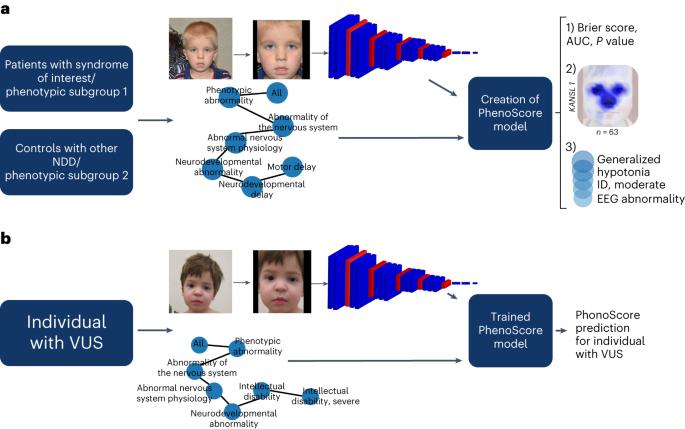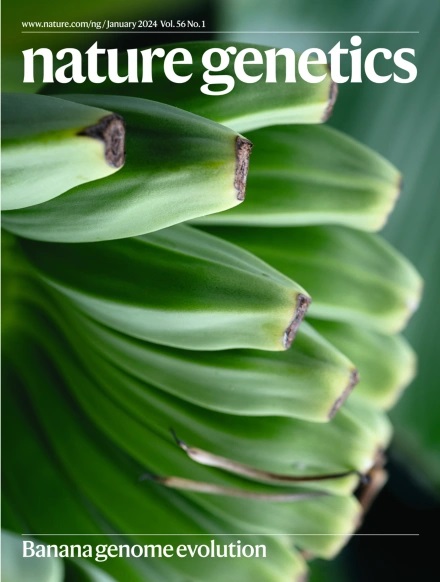PhenoScore quantifies phenotypic variation for rare genetic diseases by combining facial analysis with other clinical features using a machine-learning framework
IF 31.7
1区 生物学
Q1 GENETICS & HEREDITY
引用次数: 0
Abstract
Several molecular and phenotypic algorithms exist that establish genotype–phenotype correlations, including facial recognition tools. However, no unified framework that investigates both facial data and other phenotypic data directly from individuals exists. We developed PhenoScore: an open-source, artificial intelligence-based phenomics framework, combining facial recognition technology with Human Phenotype Ontology data analysis to quantify phenotypic similarity. Here we show PhenoScore’s ability to recognize distinct phenotypic entities by establishing recognizable phenotypes for 37 of 40 investigated syndromes against clinical features observed in individuals with other neurodevelopmental disorders and show it is an improvement on existing approaches. PhenoScore provides predictions for individuals with variants of unknown significance and enables sophisticated genotype–phenotype studies by testing hypotheses on possible phenotypic (sub)groups. PhenoScore confirmed previously known phenotypic subgroups caused by variants in the same gene for SATB1, SETBP1 and DEAF1 and provides objective clinical evidence for two distinct ADNP-related phenotypes, already established functionally. PhenoScore is an open-source machine-learning tool that combines facial image recognition with Human Phenotype Ontology for genetic syndrome identification without genomic data, with applications to subgroup analysis and variants of unknown significance classification.

PhenoScore通过使用机器学习框架将面部分析与其他临床特征相结合,量化罕见遗传疾病的表型变异。
存在几种建立基因型-表型相关性的分子和表型算法,包括面部识别工具。然而,不存在直接调查个人面部数据和其他表型数据的统一框架。我们开发了PhenoScore:一个开源的、基于人工智能的表型学框架,将面部识别技术与人类表型本体数据分析相结合,以量化表型相似性。在这里,我们通过针对在患有其他神经发育障碍的个体中观察到的临床特征,为40种研究综合征中的37种建立可识别的表型,展示了PhenoScore识别不同表型实体的能力,并表明这是对现有方法的改进。PhenoScore为具有未知意义的变异的个体提供预测,并通过测试可能的表型(亚)组的假设来进行复杂的基因型表型研究。PhenoScore证实了先前已知的由SATB1、SETBP1和DEAF1的同一基因变体引起的表型亚群,并为两种不同的ADNP相关表型提供了客观的临床证据,这两种表型已经在功能上建立。
本文章由计算机程序翻译,如有差异,请以英文原文为准。
求助全文
约1分钟内获得全文
求助全文
来源期刊

Nature genetics
生物-遗传学
CiteScore
43.00
自引率
2.60%
发文量
241
审稿时长
3 months
期刊介绍:
Nature Genetics publishes the very highest quality research in genetics. It encompasses genetic and functional genomic studies on human and plant traits and on other model organisms. Current emphasis is on the genetic basis for common and complex diseases and on the functional mechanism, architecture and evolution of gene networks, studied by experimental perturbation.
Integrative genetic topics comprise, but are not limited to:
-Genes in the pathology of human disease
-Molecular analysis of simple and complex genetic traits
-Cancer genetics
-Agricultural genomics
-Developmental genetics
-Regulatory variation in gene expression
-Strategies and technologies for extracting function from genomic data
-Pharmacological genomics
-Genome evolution
 求助内容:
求助内容: 应助结果提醒方式:
应助结果提醒方式:


